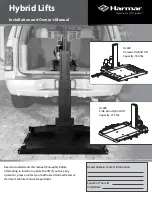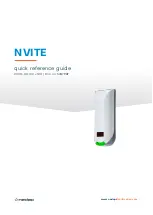
24
OPI_TOP LIFT TSK 8000_V3.2_EN
2. If the safety latches are locked, they must be
lifted with a suitable tool (hyd. lifter) if needed
until the safety latch opens due to the attached
com-pressed air.
3. Open the top cover of the external unit.
4. Unscrew the cap on the hydraulic valve (see Fig.
2a).
5. Push the “Lower” button and simultaneously
open the hydraulic valve to start the lowering
procedure.
Lowering
6. The entire lowering process must be continuous-
ly observed.
7. Once the lift is at the lowest position, the vehicle
can be driven off the lift.
8. Close the hydraulic valve again and turn on the
cap.
9. The lift must be stopped until defective parts
have been exchanges and the lift is in a techni
-
cal perfect condition again.
10. If required, do maintenance.
6.2.2 Defect of the Pneumatic valve
If there is a defect on a pneumatic valve the safety
latches cannot be opened.
However there is still the option of opening the
valve using a hand pump or compressor.
1. Open the top cover of the external unit.
2. Remove the blue pneumatic hose coming from
the lift at the pneumatic valve. (see Fig. 2b).
3. This air hose must be connected to a hand pump
or compressor. The required operating pressure
to unlock is 6 to a max. 10 bars.
4. Push the “Lower” button and lower the lift until
the lowest position is reached.
5. If the lift cannot be lowered, push the “Lift” but-
ton briefly until the latch is released. Push the
“Lower” button again until the lift has reached
the lowest position.
Lowering
11. The entire lowering process must be continuous-
ly observed.
12. Once the lift is at the lowest position, the vehicle
can be driven off the lift.
13. The lift must be stopped until defective parts
have been exchanges and the lift is in a techni
-
cal perfect condition again.
14. If required, do maintenance.
6.2.3 Defect of the hydraulic valve, defect of the
Pneumatic valve, or in case of power failure
If there is a defect in the hydraulic valve, a defect
pneumatic valve or in the case of a power failure
there is still the option of moving the lift to its lowest
position so the vehicle can be drive off the lift.
1. Open the top cover of the external unit.
2. Remove the blue pneumatic hose coming from
the lift at the pneumatic valve. (see Fig. 2b).
3. This air hose must be connected to a hand pump
or compressor. The re-quired operating pressure
to unlock is 6 to a max. 10 bars.
4. The latches must unlock.
5. If the safety latches are locked, they must be
lifted with a suitable tool (hyd. lifter) if needed
until the safety latch opens due to the attached
compressed air.
6. Unscrew the cap on the hydraulic valve (see Fig.
2a).
7. Open the hydraulic valve to start the lowering
procedure.
Lowering
8. The entire lowering process must be continuous-
ly observed.
9. Once the lift is at the lowest position, the vehicle
can be driven off the lift.
10. The lift must be stopped until defective parts
have been exchanges and the lift is in a techni
-
cal perfect condition again.
11. If required, do maintenance.
7
Maintenance and care of the system
Before maintenance, do all prepara-
tion work so there is no danger to life or
limb or object damage during mainte-
nance and repair work on the lift.
Содержание TSK 8000
Страница 2: ...2 OPI_TOP LIFT TSK 8000_V3 2_EN...
Страница 4: ......
Страница 9: ...OPI_TOP LIFT TSK 8000_V3 2_EN 9...
Страница 20: ...20 OPI_TOP LIFT TSK 8000_V3 2_EN...
Страница 44: ...44 OPI_TOP LIFT TSK 8000_V3 2_EN...
Страница 45: ...TOP LIFT TSK 8000 Serial No Made in Germany Spare parts list...
Страница 51: ...OPI_TOP LIFT TSK 8000_V3 2_EN 51...
















































